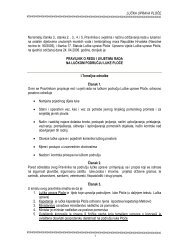HEADING PAGE - port of ploce authority * welcome
HEADING PAGE - port of ploce authority * welcome
HEADING PAGE - port of ploce authority * welcome
Create successful ePaper yourself
Turn your PDF publications into a flip-book with our unique Google optimized e-Paper software.
ENVIRONMENTAL IMPACT STUDY<br />
Rn: 03-033 CONTAINER TERMINAL PLOCE <strong>PAGE</strong>:56/6<br />
<strong>of</strong> countries do not have required standards for sediment pollution estimate. In<br />
such cases, the government authorities use <strong>of</strong>ten the recommended values<br />
based on reference concentrations. However, some ICES members (Norway,<br />
Sweden and the Netherlands) regulated the sediment classification, which<br />
may be based on concentration <strong>of</strong> single contaminant (Table 3).<br />
Country Legislation Notes<br />
Belgium x Data compared against OSPAR BC<br />
Denmark x Locally derived BCs from reference sediment (mainly for metals)<br />
Finland x<br />
France x Data compared against OSPAR BRC and locally derived BCs<br />
Irland x<br />
Canada ? ISQG and PEL approach from field data demonstrating<br />
associations between chemistry and biological effects.<br />
Netherlands yes Two-class system (NEC and MPC) based on equilibrium<br />
partitioning or ecotoxicological data.<br />
Norway yes Five class system. Data compared against local, surface<br />
sediment concentrations.<br />
Germany x<br />
Portugal x Data compared against OSPAR BC.<br />
Spain x Data compared with international (e.g. USEPA) and locally<br />
derived BCs<br />
Sweden yes Five-class system.. BCs derived from cored sediments<br />
UK<br />
(England<br />
and Wales)<br />
x Data compared against OSPAR BRC: locally derived BCs in<br />
preparation<br />
Table 3: Summary <strong>of</strong> Environmental Quality Standards for sediments in International<br />
Council for the Exploration <strong>of</strong> the Sea (ICES) Members Countries<br />
x= standards not currently covered by legislation BRC=<br />
Background/reference concentration<br />
ISQA = Interim sediment quality guidelines PEL= Probable<br />
effects level<br />
USEPA= United States Environmental Protection Agency BC = background<br />
concentration<br />
NEC= No effect concentration MPC = Maximum<br />
Permissible Concentration<br />
Norwegian and Swedish standards predict five-class sediment classification.<br />
Sediment classification standards in Norway are given in the Table 4.<br />
Contaminant Unit Class 1 Class 2 Class 3 Class 4 Class 5<br />
(good) (moderate) (poor) (bad)<br />
(very bad)<br />
Cooper mg/kg < 35 35 - 150 150 - 700 700 - 1500 > 1500<br />
Zinc mg/kg < 150 150 - 650 650 - 3000 3000- 10000 > 10000<br />
Cadmium mg/kg 10<br />
Chromium mg/kg < 70 70 - 300 300 - 1500 1500 - 5000 > 5000<br />
Nickel mg/kg 1500<br />
Lead mg/kg 1500<br />
Mercury mg/kg 5<br />
Total PAH µg/kg 20000<br />
PCB µg/kg < 5 5-25 25-100 100-300 >300<br />
Table 4: Sediment classification with respect to pollution grade in Norway, in < 2mm fraction,<br />
dry weight<br />
By comparing the defined maximum values <strong>of</strong> single contaminant in sediment<br />
to be dredged at the Port <strong>of</strong> Ploce with limit values in Norwegian standards<br />
the implication is as follows:<br />
- cooper, chromium, PAH and PCB meet limit values for the 1 st class<br />
RIJEKAPROJEKT d.o.o.



